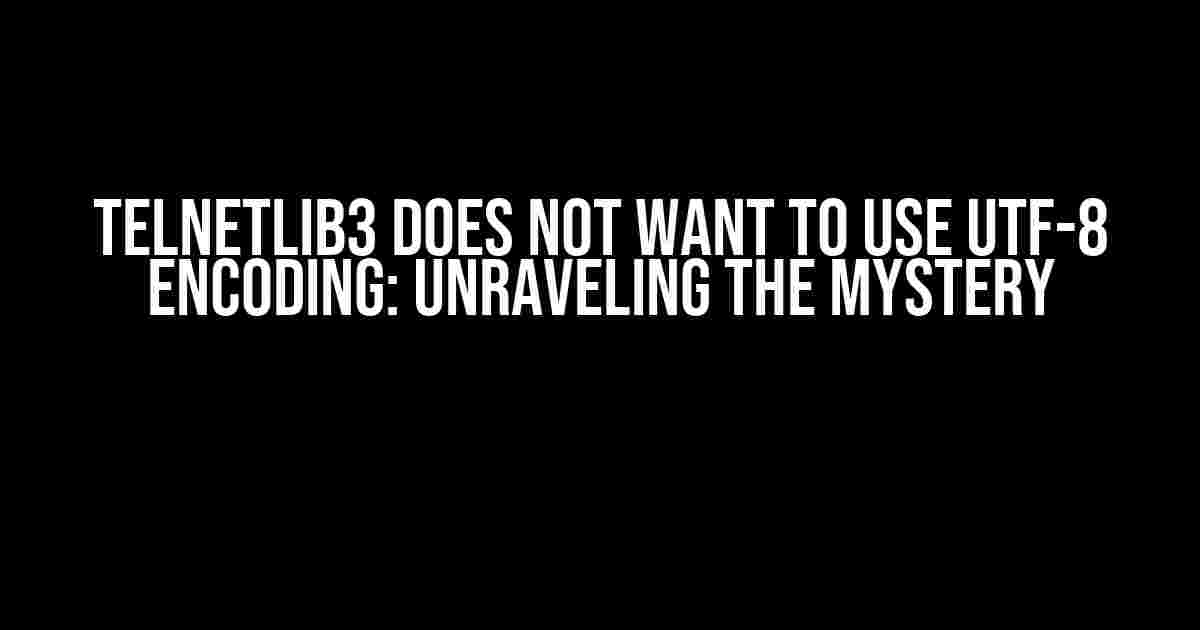Are you tired of dealing with telnetlib3’s stubborn refusal to use UTF-8 encoding? You’re not alone! Many developers have struggled with this issue, only to be left scratching their heads. Fear not, dear reader, for we’re about to dive into the depths of telnetlib3’s encoding conundrum and emerge victorious on the other side.
What is Telnetlib3 and Why Does it Matter?
Before we dive into the meat of the issue, it’s essential to understand what telnetlib3 is and why it’s important. Telnetlib3 is a Python library that provides a telnet client implementation. It’s commonly used for automating interactions with remote devices, such as network switches, routers, and other network-attached devices. With telnetlib3, you can send commands, retrieve output, and even automate complex tasks.
Now, you might wonder why encoding matters in telnetlib3. The answer is simple: encoding affects how characters are transmitted and interpreted between the client and server. In our case, we want to use UTF-8 encoding to ensure that special characters, accents, and non-ASCII characters are transmitted correctly.
The Problem: Telnetlib3 and UTF-8 Encoding Don’t Mix
So, why does telnetlib3 refuse to play nicely with UTF-8 encoding? The reason lies in its implementation. By default, telnetlib3 uses the ASCII encoding, which is a 7-bit character set that doesn’t support extended characters. This means that any special characters, such as accents or non-ASCII characters, will be lost in translation.
To illustrate this, let’s take a simple example. Suppose we want to send the string “Hëllo, Wørld!” to a remote device using telnetlib3. Without proper encoding, the string will be mangled, resulting in “H?llo, W?rld!”. This is because the ASCII encoding can’t handle the special characters in the original string.
Why Does Telnetlib3 Use ASCII Encoding by Default?
Telnetlib3’s default encoding is rooted in its historical roots. The telnet protocol was originally designed to work with ASCII characters, which were the standard for early computing. As a result, the telnetlib3 implementation followed suit, using ASCII encoding as its default.
However, this default encoding has become a limitation in modern times. With the widespread adoption of Unicode and UTF-8 encoding, it’s essential to support these newer character sets. Unfortunately, telnetlib3’s implementation hasn’t kept pace with these changes, leaving us with the encoding conundrum we’re trying to solve.
Solving the Problem: Forcing Telnetlib3 to Use UTF-8 Encoding
Now that we understand the problem, it’s time to explore solutions. Fortunately, we can override telnetlib3’s default encoding and force it to use UTF-8 encoding. Here’s how:
Method 1: Using the encode() Function
One way to force telnetlib3 to use UTF-8 encoding is by using the encode() function. This method converts the string to bytes using the UTF-8 encoding, which telnetlib3 can then transmit correctly.
import telnetlib3
# Create a telnet session
tn = telnetlib3.Telnet('localhost')
# Define a string with special characters
string_to_send = 'Hëllo, Wørld!'
# Encode the string using UTF-8
encoded_string = string_to_send.encode('utf-8')
# Send the encoded string to the remote device
tn.write(encoded_string + b'\n')
Method 2: Subclassing Telnetlib3 and Overriding the encoding Property
Another approach is to subclass telnetlib3’s Telnet class and override its encoding property. This method allows us to set the encoding globally for all telnet sessions.
import telnetlib3
class UTF8Telnet(telnetlib3.Telnet):
def __init__(self, host, port=23):
super().__init__(host, port)
self.encoding = 'utf-8'
# Create a telnet session using our custom class
tn = UTF8Telnet('localhost')
# Define a string with special characters
string_to_send = 'Hëllo, Wørld!'
# Send the string to the remote device
tn.write(string_to_send + '\n')
Troubleshooting Common Issues
While the above methods should solve the encoding issue, you might encounter some common problems along the way. Here are some troubleshooting tips to help you overcome these obstacles:
Issue 1: UnicodeDecodeError
If you encounter a UnicodeDecodeError, it’s likely because the remote device is sending data in an unexpected encoding. To resolve this, try setting the encoding property to ‘latin-1’ or another suitable encoding that matches the remote device’s character set.
Issue 2: Garbled Output
If the output from the remote device appears garbled or contains unexpected characters, check the encoding of the data being received. Ensure that the encoding matches the character set used by the remote device.
Issue 3: telnetlib3 Version Incompatibility
Some older versions of telnetlib3 might not support overriding the encoding property or using the encode() function. If you’re using an older version, consider upgrading to a newer version that supports these features.
Conclusion
Telnetlib3’s reluctance to use UTF-8 encoding can be frustrating, but with the right approaches, you can overcome this limitation. By using the encode() function or subclassing Telnetlib3 to override the encoding property, you can ensure that special characters and non-ASCII characters are transmitted correctly. Remember to troubleshoot common issues, and don’t hesitate to seek help if you encounter any problems along the way. Happy coding!
| Method | Advantages | Disadvantages |
|---|---|---|
| Using the encode() function | Easy to implement, works with existing telnetlib3 code | Requires manual encoding for each string, can be cumbersome |
| Subclassing Telnetlib3 and overriding the encoding property | Global encoding setting, applies to all telnet sessions | Requires creating a custom class, might not work with older telnetlib3 versions |
Now that you’ve mastered the art of forcing telnetlib3 to use UTF-8 encoding, go forth and conquer the world of telnet automation! Remember to share your experiences and tips with the community, and don’t hesitate to ask for help if you encounter any issues.
- Try using telnetlib3 with UTF-8 encoding for a simple task, such as sending a command to a remote device.
- Research and explore other telnet libraries that support UTF-8 encoding by default.
With these tips and tricks, you’re ready to take on the world of telnet automation with confidence. Remember, the power is in your hands – or rather, in your code!
Frequently Asked Question
Telnetlib3, the popular Python library for Telnet connections, has been causing some encoding headaches lately. Don’t worry, we’ve got you covered! Check out the most frequently asked questions about Telnetlib3 and UTF-8 encoding below.
Why does Telnetlib3 refuse to use UTF-8 encoding by default?
Telnetlib3 adheres to the Telnet protocol’s original specification, which doesn’t mandate UTF-8 encoding. As a result, it defaults to ASCII encoding. However, this can be overridden by setting the encoding parameter when creating a Telnet connection.
How can I force Telnetlib3 to use UTF-8 encoding for my Telnet connection?
To enable UTF-8 encoding, simply pass the encoding parameter with the value ‘utf-8’ when creating a Telnet connection. For example: tn = telnetlib3.Telnet('host', encoding='utf-8'). This will ensure that all data sent and received over the connection is encoded in UTF-8.
What are the implications of not using UTF-8 encoding with Telnetlib3?
If you don’t specify UTF-8 encoding, you may encounter issues with characters that aren’t part of the ASCII character set. This can lead to garbled or incorrect text being displayed, especially when dealing with non-English languages. By using UTF-8 encoding, you ensure that all characters are properly represented and transmitted.
Are there any alternative libraries that support UTF-8 encoding out of the box?
Yes, there are alternative libraries like Paramiko, which provides a more comprehensive and modern implementation of SSH and Telnet connections. Paramiko supports UTF-8 encoding by default, making it a great option if you need to work with non-ASCII characters.
Can I use Telnetlib3 with UTF-8 encoding in Python 2.x?
While Telnetlib3 can be used with Python 2.x, it’s essential to note that the default encoding in Python 2.x is ASCII, which can lead to issues with UTF-8 encoding. To avoid problems, ensure that you specify the encoding parameter with the value ‘utf-8’ when creating a Telnet connection. Additionally, consider using Python 3.x, which has better support for Unicode and UTF-8 encoding.


